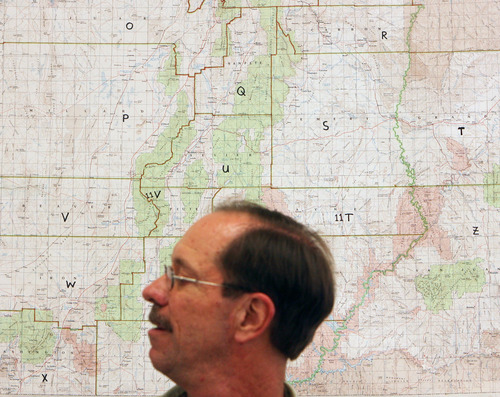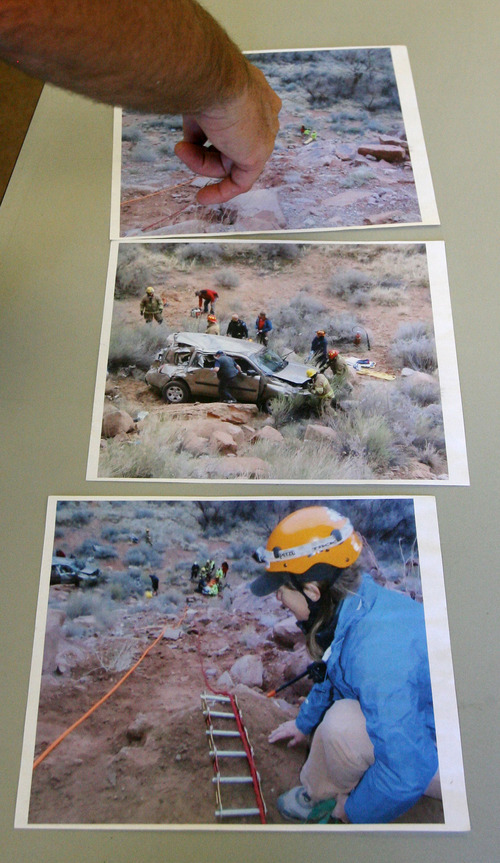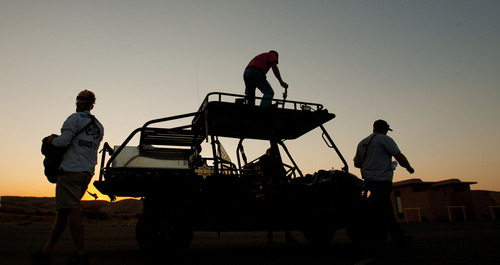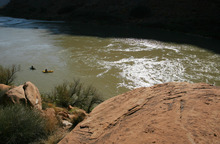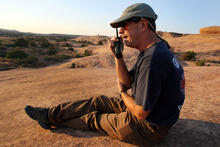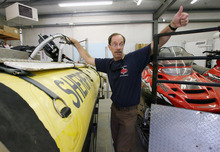This is an archived article that was published on sltrib.com in 2012, and information in the article may be outdated. It is provided only for personal research purposes and may not be reprinted.
Moab • On March 25, Miriam Babineau was on a spring break trip with her husband and children when she drove up a hill, went over a steep rock and her all-terrain vehicle flipped backward on the Seven Mile Rim Trail north of Moab.
The ATV fell on top of her. Babineau broke 18 ribs, punctured one lung, collapsed both lungs and broke her left collarbone. A helicopter landed along the trail and flew her to a hospital. A few weeks later, Babineau, a 52-year-old resident of McCall, Idaho, was still recuperating when she received a bill in the mail she wasn't expecting.
It wasn't from a doctor or an ambulance service. It was a $750 bill from Grand County Search and Rescue.
"I will pay the bill," Babineau said last month, "but am I crazy about it? Not so much."
The bill could have been a lot higher if Babineau had gotten hurt in Wayne County's Blue John Canyon. Wayne County's search and rescue team last year sent a $4,000 bill to Amos Richards, the then-64-year-old North Carolina man who made national news when he spent four days hiking out of that canyon on a broken ankle before rescuers found him.
"It surprised me," Richards said in a telephone interview last month, "because they told me when they rescued me, 'You might have to pay gas for the helicopter.' But I didn't realize it would be that much."
Grand and Wayne counties are believed to be the only counties in Utah and two of the few in the United States that charge for search and rescue services. Sheriffs in both counties say searches and rescues are expensive, they don't have the tax revenue to pay for all of them and the majority of people who need rescue don't live in their counties, anyway. Why should locals have to pay to find and save tourists?
"If you knowingly, purposely intentionally put yourself in harm's way, you should be responsible for that," said Wayne County Sheriff Kurt Taylor.
In a position statement on its website, the National Association For Search & Rescue opposes billing. The organization provided a list of 14 examples where it was discovered later someone waited to call 911 or refused help because he or she was worried about fees.
"The mission of [search and rescue] organizations is to save lives, not just the lives of those who can afford to pay the bill," the position statement says.
But Grand County Sheriff Steve White said he's never heard of a case in his county where someone in the outdoors waited or refused to call for help for fear of paying.
"If somebody's hurt, we're coming no matter what," White said, "whether the bill [gets] paid or it doesn't."
In Grand County, a lot of the bills don't get paid.
Records provided by Grand County show that in 2011 it sent bills for 52 search and rescue operations totaling $39,140.
But Grand County collected only $22,917. In 14 cases, the rescuee didn't pay, records show. In 11 other cases, the recipient paid only a portion of the bill.
Grand County charged and collected more in 2010. That year, the county charged $77,449 for 53 search and rescues. It received $60,626.
Diana Carroll, the Grand County clerk, said in an email that a billing company pursues the fees for six months. But taking unpaid bills to court, Carroll said, would cost more than what is owed.
Jim Nyland, who implemented the search and rescue fees while sheriff in the early 1990s, said he was trying to protect local taxpayers and make people accountable for their actions.
"People come here to recreate and get themselves into situations that they aren't familiar with and can't handle," said Nyland, who now serves on the Grand County Council.
Sheriff's deputies and search and rescue personnel tell stories about people who visit Grand County and hike in 110-degree heat with only a small bottle of water, raft without flotation devices when the river is swollen or ride or drive mountain bikes, ATVs or Jeeps on trails that are too challenging.
Jim Fife, of Grand Junction, Colo., doesn't feel he was doing anything too dangerous, but he still paid a $1,500 bill to Grand County. In 2008, Fife was rafting the Colorado River in Westwater Canyon. His raft flipped on the first rapid, throwing him, his wife and a friend out of the boat. Fife's wife and friend climbed onto another raft while Fife swam to shore. The rest of his party went down river. Fife, then age 60, planned to stay the night on shore and flag down a passing boat in the morning.
But a river guide called the Grand County Sheriff's Office. Search and rescue responded. A boat driven by Bureau of Land Management personnel picked up Fife that night.
Fife, in an interview last month, said the bill was "pretty reasonable" and he paid it even though he says he didn't need rescuing.
"It was total overkill," Fife said of the search and rescue response. "On the other hand, if I needed them, I would be grateful for it."
But Fife and Babineau question how much Grand County personnel did for them. It was BLM employees who retrieved Fife. Babineau said the helicopter from St. Mary's Hospital in Grand Junction arrived before search and rescue did.
"I'm not sure [Grand County Search and Rescue] actually had to do anything when they got there," Babineau said.
White said just sending personnel out the door costs money, and even in cases where someone else finds the troubled party first, Grand County Search and Rescue may have spent time looking.
Grand County doesn't charge everyone. If the victim is dead or dies, no bill is sent to the next of kin. Grand County also won't charge if the rangers at Arches or Canyonlands national parks ask for help finding or rescuing someone. White said he considers that to be assisting another agency, something that's a courtesy in law enforcement.
Those who do receive a bill have little warning it's coming. Grand County's billing rate is a public record available upon request. But neither the rates nor advisements telling people they could be billed are published in any of the brochures or travel guides promoting the Moab area.
Grand County Search and Rescue Commander Jim Webster said promoting the fees might deter someone from calling for help. Webster's rescuers also don't mention the fees while helping someone. The person is already under enough stress, Webster said.
"If they ask, we'll tell them," Webster said. "Most of our guys don't even know the fees."
According to data kept by the state, Grand County consistently leads the state in the number of searches and rescues. While most rural counties rely on volunteers to be on their search and rescue teams, Grand County employs people on a part-time basis to respond to calls.
The search and rescue force currently has 23 members and three trainees. For the current fiscal year, Grand County has budgeted $60,443 for search and rescue salaries and another $5,329 for overtime, according to county documents.
White said some members of the volunteer crews had a hard time holding down jobs and responding to search and rescue calls. And being on the team requires training and refresher courses.
Wayne County has a lot fewer searchers and rescues and has invoiced a lot less than its northeast neighbor. Wayne County collected $15,959 in 2011, the first year it started charging.
Taylor said his county began charging after the film "127 Hours" inspired travelers to visit Blue John Canyon, where hiker Aron Ralston was trapped by a boulder and had to amputate his own arm in 2003. The canyon is a five- or six-hour round-trip drive from Loa, the county seat and where many of the search and rescue volunteers live. Rescues in the canyon often require climbing and specialized training or a phone call requesting a Utah Department of Public Safety helicopter.
Unlike in Grand County, Wayne County has no standardized fees and firm rules about who gets billed. If a hiker is behaving responsibly and is unlucky enough to have a boulder come loose and hit him, for example, Taylor says his county won't send the hiker a bill. But in cases like Richards, the county considers how many people it had to deploy and whether the victim shares some blame for his plight.
"Should he have been there on his own? Absolutely not," Taylor said. "Should he have left better information with his family to let them know where he'd gone? Absolutely."
Richards, the North Carolina man, is among those who went to Blue John Canyon after seeing "127 Hours." But the side trip to the canyon was a last-minute decision. He didn't tell anyone he was going there. A sign at the mouth of the canyon warned him he could be billed for a rescue.
While climbing in the canyon, he couldn't get a foothold, fell and broke his ankle. Richards had already pitched a tent in a campground at Canyonlands National Park, and when he didn't return, rangers started looking for him, found his car at the trail head to Blue John Canyon, and called Wayne County search and rescue.
A park service ranger found Richards about 2 p.m. on Sept. 11, 2011. The Wayne County searchers were at the trail head when Richards arrived there, he said.
Richards said he paid his bill in four $1,000 installments.
Richards returned to Blue John Canyon on Aug. 5 of this year. This time, he was careful and didn't have any accidents.
"Now when I go out," Richards said, "I think more about the money than anything else."
Twitter: @natecarlisle —
What does a rescue cost?
Grand County recently adopted a new fee schedule. It went into effect Sept. 14.
Base rate • $500
More charges:
Backcountry carry-out • $400
ATVs used • $125 per vehicle
Boats used • $125 per unit
Personal watercraft used • $125 per unit
Snowmobiles used • $125 per unit
Low-angle rope evacuation • $400
High-angle rope evacuation • $800
Source: Grand County Search and Rescue —]
Will insurance pay?
Miriam Babineau said her medical insurance would not pay the $750 search and rescue bill because it was not considered a medical expense.
#
What Wayne County charges for rescues
Wayne County has a base rate of $600 for a call out followed by a cancellation or $1,200 if personnel respond and perform a rescue operation. There are additional fees according to what services and equipment are required.
Source: Wayne County Sheriff Kurt Taylor


